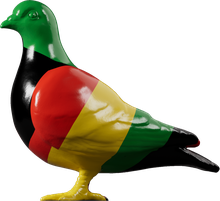Saxon & Medieval — Late Medieval; 14th-15th century
Comb
Secular badge in the shape of a double-sided comb. It was originally thought that this was a pilgrim badge from the shrine of St Blaise at Canterbury Cathedral in Kent. St Blaise was martyred in the early 4th century by being torn apart by iron combs and then beheaded. Some of the relics of St Blaise were kept at Canterbury Cathedral in a shrine by the high altar. Badges of St Blaise may depict combs, though they are more likely to be in the form of wool combs rather than hair combs. Closer inspection of the band of decoration in centre of this badge revealed that it is decorated with four phalluses connected by a wavy line. This indicates that the badge is sexual or satirical rather than religious. Many phallic badges have been found in the Netherlands and comb badges are known with copulating couples depicted on them (see 'Heilig en Profaan 2' (2001) by van Beuningen & Koldeweij, pg. 407, cat. no. 1729). Comb badges like this may be a visual pun: the Anglo-Norman (the type of French that came to England with the Norman invasion of 1066) word for 'little comb' was 'penil', which also meant 'penis', 'pubes' or 'groin'. This pun would still have existed in the 14th and 15th centuries.
- Category:
- Saxon & Medieval
- Object ID:
- 8737
- Object name:
- Comb
- Object type:
- Artist/Maker:
- —
- Related people:
- Related events:
- Related places:
- Production date:
- Late Medieval; 14th-15th century
- Material:
lead alloy
- Measurements/duration:
- H 32 mm, W 28 mm
- Part of:
- —
- On display:
- —
- Record quality:
- 100%
- Part of this object:
- —
- Owner Status & Credit:
Permanent collection
- Copyright holder:
digital image © London Museum
- Image credit:
- —
- Creative commons usage:
- —
- License this image:
To license this image for commercial use, please contact the London Museum Picture Library.

